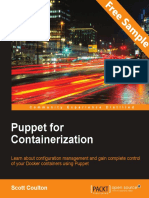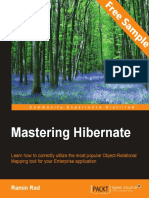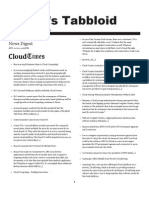RESTful Web API Design With Node - Js - Sample Chapter
Uploaded by
Packt PublishingRESTful Web API Design With Node - Js - Sample Chapter
Uploaded by
Packt PublishingFr
ee
In this era of cloud computing, every data provisioning
solution is built in a scalable and fail-safe way. Thus,
when building RESTful services, the right choice of the
underlying platform is vital. Node.js, with its
asynchronous, event-driven architecture, is just the right
choice to build RESTful APIs.
This book will be your step-by-step guide in the
RESTful world of Node.js. It starts with the
implementation of a simple HTTP handler application
and follows its evolution to a completed RESTful service
solution, which introduces you to the best practices in
developing RESTful services.
Who this book is written for
Learn about NoSQL data stores and
integrate MongoDB in your Node.js
application with Mongoose
Install, develop, and test your own Node.js
user modules
P U B L I S H I N G
pl
C o m m u n i t y
Comprehend the differences between
an HTTP and RESTful application
Optimize RESTful service URI routing
with best practices
Secure your services with NoSQL database
integration within Node.js applications
$ 29.99 US
19.99 UK
community experience distilled
Sa
m
Eliminate third-party dependencies in
your tests with mocking
Valentin Bojinov
If you are a web developer wanting to enrich
your development skills to create scalable, server-side,
RESTful applications based on the Node.js platform,
this book is for you. You also need to be aware of
HTTP communication concepts and should have a
working knowledge of JavaScript. Knowledge of REST
would be an added advantage but is definitely not
a necessity.
What you will learn from this book
RESTful Web API Design with Node.js
RESTful Web API
Design with Node.js
D i s t i l l e d
RESTful Web API
Design with Node.js
Design and implement comprehensive RESTful solutions
in Node.js
Prices do not include
local sales tax or VAT
where applicable
Visit www.PacktPub.com for books, eBooks,
code, downloads, and PacktLib.
E x p e r i e n c e
Valentin Bojinov
In this package, you will find:
The author biography
A preview chapter from the book, Chapter 1 'REST What You Didn't Know'
A synopsis of the books content
More information on RESTful Web API Design with Node.js
About the Author
Valentin Bojinov studied computer programming at Technological School of
Electronic Systems, a college within the Technical University of Sofia, Bulgaria. There,
he got acquainted with programming and realized that his career would be in research
and development. After college, he graduated from the Technical University of Sofia
with a BSc in telecommunication and information engineering. It was then that his
interest in data transmission grew and he ventured into B2B (business-to-business)
communication. He is currently working on his MSc degree in software development.
He is an expert in Java, SOAP, RESTful web services, and B2B integration.
A few years after Valentin started his career as a .NET developer, he realized that B2B
and SOA were his passion. He then moved to SAP, where he contributed to the
development of the web services stack of the SAP JEE platform. He currently works as
a senior Java developer for the Bulgarian branch of Seeburger AG, a leader in the B2B
and MFT solutions market. There, he develops and maintains several B2B
communication adapters, including web services and SAP adapters.
RESTful Web API Design
with Node.js
RESTful services have become the de facto standard data feed providers for social
services, news feeds, and mobile devices. They deliver a large amount of data to millions
of users. Thus, they need to address high-availability requirements, such as reliability and
scalability. This book will show you how to utilize the Node. js platform to implement a
robust and performant data service. By the end of this book, you will have learned how to
implement a real-life RESTful service, taking advantage of the modern NoSQL database
to serve both JSON and binary content.
Important topics such as correct URI structuring and security features are also covered,
with detailed examples, showing you everything you need to know to start implementing
the robust RESTful APIs that serve content for your applications.
What This Book Covers
Chapter 1, REST What You Didn't Know, introduces the history of REST and how it
couples with the HTTP protocol.
Chapter 2, Getting Started with Node.js, teaches you how to install Node.js and work
with its package manager to install modules. It is in this chapter that you develop your
first HTTP server application.
Chapter 3, Building a Typical Web API, takes you through structuring your application
using human-readable URL and URI parameters. You get to develop a read-only
RESTful service application using the filesystem for storage.
Chapter 4, Using NoSQL Databases, showcases how to use the LevelDB and
MongoDB NoSQL databases, and explains the difference between key-value and
document data stores.
Chapter 5, Implementing a Full-fl edged RESTful Service, takes you through
implementing a production-ready RESTful service that uses NoSQL to store its data.
You get to learn how to handle binary data and how to version an API while it evolves.
Chapter 6, Keeping the Bad Guys Out, covers restricting access to your data by
choosing an appropriate authentication approach. Now you can protect data leakage
with transport layer security.
REST What You
Didn't Know
Nowadays, topics such as cloud computing and mobile device service feeds, and
other data sources being powered by cutting-edge, scalable, stateless, and modern
technologies such as RESTful web services, leave the impression that REST has been
invented recently. Well, to be honest, it is definitely not! In fact, REST was defined at
the end of the 20th century.
This chapter will walk you through REST's history and will teach you how REST
couples with the HTTP protocol. You will look at the five key principles that need
to be considered while turning an HTTP application into a RESTful-service-enabled
application. You will also look at the differences between RESTful and SOAP-based
services. Finally, you will learn how to utilize already existing infrastructure for
your benefit.
In this chapter, we will cover the following topics:
A brief history of REST
REST with HTTP
RESTful versus SOAP-based services
Taking advantage of existing infrastructure
[1]
REST What You Didn't Know
A brief history of REST
Let's look at a time when the madness around REST made everybody talk restlessly
about it! This happened back in 1999, when a request for comments was submitted to
the Internet Engineering Task Force (IETF: http://www.ietf.org/) via RFC 2616:
"Hypertext Transfer Protocol - HTTP/1.1." One of its authors, Roy Fielding, later
defined a set of principles built around the HTTP and URI standards. This gave birth
to REST as we know it today.
These definitions were given in Chapter 5, Implementing a Full-fldged
RESTful Service, of Fielding's dissertation called Architectural Styles and
the Design of Network-based Software Architectures. The dissertation is
still available at http://www.ics.uci.edu/~fielding/pubs/
dissertation/rest_arch_style.htm.
Let's look at the key principles around the HTTP and URI standards, sticking to
which will make your HTTP application a RESTful-service-enabled application:
Everything is a resource
Each resource is identifiable by a unique identifier (URI)
Use the standard HTTP methods
Resources can have multiple representations
Communicate statelessly
Principle 1 everything is a resource
To understand this principle, one must conceive the idea of representing data by a
specific format and not by a physical file. Each piece of data available on the Internet
has a format that could be described by a content type. For example, JPEG Images;
MPEG videos; html, xml, and text documents; and binary data are all resources with
the following content types: image/jpeg, video/mpeg, text/html, text/xml, and
application/octet-stream.
[2]
Chapter 1
Principle 2 each resource is identifiable by a
unique identifier
Since the Internet contains so many different resources, they all should be accessible
via URIs and should be identified uniquely. Furthermore, the URIs can be in a humanreadable format (frankly I do believe they should be), despite the fact that their
consumers are more likely to be software programmers rather than ordinary humans.
The URI keeps the data self-descriptive and eases further development on it. In
addition, using human-readable URIs helps you to reduce the risk of logical errors in
your programs to a minimum.
Here are a few sample examples of such URIs:
http://www.mydatastore.com/images/vacation/2014/summer
http://www.mydatastore.com/videos/vacation/2014/winter
http://www.mydatastore.com/data/documents/balance?format=xml
http://www.mydatastore.com/data/archives/2014
These human-readable URIs expose different types of resources in a straightforward
manner. In the example, it is quite clear that the resource types are as follows:
Images
Videos
XML documents
Some kinds of binary archive documents
Principle 3 use the standard HTTP methods
The native HTTP protocol (RFC 2616) defines eight actions, also known as verbs:
GET
POST
PUT
DELETE
HEAD
OPTIONS
TRACE
CONNECT
[3]
REST What You Didn't Know
The first four of them feel just natural in the context of resources, especially when
defining actions for resource data manipulation. Let's make a parallel with relative
SQL databases where the native language for data manipulation is CRUD (short
for Create, Read, Update, and Delete) originating from the different types of SQL
statements: INSERT, SELECT, UPDATE and DELETE respectively. In the same
manner, if you apply the REST principles correctly, the HTTP verbs should be used
as shown here:
HTTP verb
Action
Response status code
GET
Request an existing
resource
"200 OK" if the resource exists, "404 Not Found" if
it does not exist, and "500 Internal Server Error" for
other errors
PUT
Create or update a
resource
"201 CREATED" if a new resource is created, "200
OK" if updated, and "500 Internal Server Error" for
other errors
POST
Update an existing
resource
"200 OK" if the resource has been updated
successfully, "404 Not Found" if the resource to be
updated does not exist, and "500 Internal Server
Error" for other errors
DELETE
Delete a resource
"200 OK" if the resource has been deleted
successfully, "404 Not Found" if the resource to be
deleted does not exist, and "500 Internal Server
Error" for other errors
There is an exception in the usage of the verbs, however. I just mentioned that POST
is used to create a resource. For instance, when a resource has to be created under a
specific URI, then PUT is the appropriate request:
PUT /data/documents/balance/22082014 HTTP/1.1
Content-Type: text/xml
Host: www.mydatastore.com
<?xml version="1.0" encoding="utf-8"?>
<balance date="22082014">
<Item>Sample item</Item>
<price currency="EUR">100</price>
</balance>
HTTP/1.1 201 Created
Content-Type: text/xml
Location: /data/documents/balance/22082014
[4]
Chapter 1
However, in your application you may want to leave it up to the server REST
application to decide where to place the newly created resource, and thus create it
under an appropriate but still unknown or non-existing location.
For instance, in our example, we might want the server to create the date part of the
URI based on the current date. In such cases, it is perfectly fine to use the POST verb
to the main resource URI and let the server respond with the location of the newly
created resource:
POST /data/documents/balance HTTP/1.1
Content-Type: text/xml
Host: www.mydatastore.com
<?xml version="1.0" encoding="utf-8"?>
<balance date="22082014">
<Item>Sample item</Item>
<price currency="EUR">100</price>
</balance>
HTTP/1.1 201 Created
Content-Type: text/xml
Location: /data/documents/balance
Principle 4 resources can have multiple
representations
A key feature of a resource is that they may be represented in a different form than
the one it is stored. Thus, it can be requested or posted in different representations.
As long as the specified format is supported, the REST-enabled endpoint should use
it. In the preceding example, we posted an xml representation of a balance, but if the
server supported the JSON format, the following request would have been valid as
well:
POST /data/documents/balance HTTP/1.1
Content-Type: application/json
Host: www.mydatastore.com
{
"balance": {
"date": ""22082014"",
"Item": "Sample item",
"price": {
[5]
REST What You Didn't Know
"-currency": "EUR",
"#text": "100"
}
}
}
HTTP/1.1 201 Created
Content-Type: application/json
Location: /data/documents/balance
Principle 5 communicate statelessly
Resource manipulation operations through HTTP requests should always be
considered atomic. All modifications of a resource should be carried out within an
HTTP request in isolation. After the request execution, the resource is left in a final
state, which implicitly means that partial resource updates are not supported. You
should always send the complete state of the resource.
Back to the balance example, updating the price field of a given balance would mean
posting a complete JSON document that contains all of the balance data, including the
updated price field. Posting only the updated price is not stateless, as it implies that the
application is aware that the resource has a price field, that is, it knows its state.
Another requirement for your RESTful application is to be stateless; the fact that
once deployed in a production environment, it is likely that incoming requests are
served by a load balancer, ensuring scalability and high availability. Once exposed
via a load balancer, the idea of keeping your application state at server side gets
compromised. This doesn't mean that you are not allowed to keep the state of your
application. It just means that you should keep it in a RESTful way. For example,
keep a part of the state within the URI.
The statelessness of your RESTful API isolates the caller against changes at the
server side. Thus, the caller is not expected to communicate with the same server
in consecutive requests. This allows easy application of changes within the server
infrastructure, such as adding or removing nodes.
Remember that it is your responsibility to keep your RESTful APIs
stateless, as the consumers of the API would expect it to be.
[6]
Chapter 1
Now that you know that REST is around 15 years old, a sensible question would be,
"why has it become so popular just quite recently?" My answer to the question is that
we as humans usually reject simple, straightforward approaches, and most of the
time, we prefer spending more time on turning complex solutions into even more
complex and sophisticated solutions.
Take classical SOAP web services for example. Their various WS-* specifications
are so many and sometimes loosely defined in order to make different solutions
from different vendors interoperable. The WS-* specifications need to be unified by
another specification, WS-BasicProfile.
This mechanism defines extra interoperability rules in order to ensure that all
WS-* specifications in SOAP-based web services transported over HTTP provide
different means of transporting binary data. This is again described in other sets of
specifications such as SOAP with Attachment References (SwaRef) and Message
Transmission Optimisation Mechanism (MTOM), mainly because the initial idea of
the web service was to execute business logic and return its response remotely, not to
transport large amounts of data.
Well, I personally think that when it comes to data transfer, things should not be
that complex. This is where REST comes into place by introducing the concept of
resources and standard means to manipulate them.
The REST goals
Now that we've covered the main REST principles, let's dive deeper into what can be
achieved when they are followed:
Separation of the representation and the resource
Visibility
Reliability
Scalability
Performance
[7]
REST What You Didn't Know
Separation of the representation and the
resource
A resource is just a set of information, and as defined by principle 4, it can have
multiple representations. However, the state of the resource is atomic. It is up to
the caller to specify the content-type header of the http request, and then it is up
to the server application to handle the representation accordingly and return the
appropriate HTTP status code:
HTTP 200 OK in the case of success
HTTP 400 Bad request if a unsupported content type is requested, or for any
other invalid request
HTTP 500 Internal Server error when something unexpected happens during
the request processing
For instance, let's assume that at the server side, we have balance resources stored in
an XML file. We can have an API that allows a consumer to request the resource in
various formats, such as application/json, application/zip, application/octet-stream,
and so on.
It would be up to the API itself to load the requested resource, transform it into
the requested type (for example, json or xml), and either use zip to compress it or
directly flush it to the HTTP response output. It is the Accept HTTP header that
specifies the expected representation of the response data. So, if we want to request
our balance data inserted in the previous section in XML format, the following
request should be executed:
GET /data/balance/22082014 HTTP/1.1
Host: my-computer-hostname
Accept: text/xml
HTTP/1.1 200 OK
Content-Type: text/xml
Content-Length: 140
<?xml version="1.0" encoding="utf-8"?>
<balance date="22082014">
<Item>Sample item</Item>
<price currency="EUR">100</price>
</balance>
[8]
Chapter 1
To request the same balance in JSON format, the Accept header needs to be set to
application/json:
GET /data/balance/22082014 HTTP/1.1
Host: my-computer-hostname
Accept: application/json
HTTP/1.1 200 OK
Content-Type: application/json
Content-Length: 120
{
"balance": {
"date": "22082014",
"Item": "Sample item",
"price": {
"-currency": "EUR",
"#text": "100"
}
}
}
Visibility
REST is designed to be visible and simple. Visibility of the service means that every
aspect of it should self-descriptive and should follow the natural HTTP language
according to principles 3, 4, and 5.
Visibility in the context of the outer world would mean that monitoring applications
would be interested only in the HTTP communication between the REST service and
the caller. Since the requests and responses are stateless and atomic, nothing more is
needed to flow the behavior of the application and to understand whether anything
has gone wrong.
Remember that caching reduces the visibility of you restful
applications and should be avoided.
[9]
REST What You Didn't Know
Reliability
Before talking about reliability, we need to define which HTTP methods are safe
and which are idempotent in the REST context. So let's first define what safe and
idempotent methods are:
An HTTP method is considered to be safe provided that when requested, it
does not modify or cause any side effects on the state of the resource
An HTTP method is considered to be idempotent if its response is always the
same, no matter how many times it is requested
The following table lists shows you which HTTP method is safe and which is
idempotent:
HTTP Method
Safe
Idempotent
GET
Yes
Yes
POST
No
No
PUT
No
Yes
DELETE
No
Yes
Scalability and performance
So far, I have often stressed on the importance of having stateless implementation
and stateless behavior for a RESTful web application. The World Wide Web is
an enormous universe, containing a huge amount of data and a few times more
users eager to get that data. Its evolution has brought about the requirement that
applications should scale easily as their load increases. Scaling applications that have
a state is hardly possible, especially when zero or close-to-zero downtime is needed.
That's why being stateless is crucial for any application that needs to scale. In the
best-case scenario, scaling your application would require you to put another piece
of hardware for a load balancer. There would be no need for the different nodes to
sync between each other, as they should not care about the state at all. Scalability is
all about serving all your clients in an acceptable amount of time. Its main idea is
keep your application running and to prevent Denial of Service (DoS) caused by a
huge amount of incoming requests.
Scalability should not be confused with performance of an application. Performance
is measured by the time needed for a single request to be processed, not by the
total number of requests that the application can handle. The asynchronous nonblocking architecture and event-driven design of Node.js make it a logical choice for
implementing a well-scalable application that performs well.
[ 10 ]
Chapter 1
Working with WADL
If you are familiar with SOAP web services, you may have heard of the Web Service
Definition Language (WSDL). It is an XML description of the interface of the service.
It is mandatory for a SOAP web service to be described by such a WSDL definition.
Similar to SOAP web services, RESTful services also offer a description language
named WADL. WADL stands for Web Application Definition Language. Unlike
WSDL for SOAP web services, a WADL description of a RESTful service is optional,
that is, consuming the service has nothing to do with its description.
Here is a sample part of a WADL file that describes the GET operation of our
balance service:
<application xmlns="http://wadl.dev.java.net/2009/02"
xmlns:xsd="http://www.w3.org/2001/XMLSchema"
xmlns:service="http://localhost:8080/data/balance">
<grammer>
<include href="balance.xsd"/>
<include href="error.xsd"/>
</grammer>
<resources base="http://localhost:8080/data/balance/">
<resource path="{date}">
<method name="GET">
<request>
<param name="date" type="xsd:string" style="template"/>
</request>
<response status="200">
<representation mediaType="application/xml"
element="service:balance"/>
<representation mediaType="application/json" />
</response>
<response status="404">
<representation mediaType="application/xml"
element="service:balance"/>
</response>
</method>
</resource>
</resources>
</application>
[ 11 ]
REST What You Didn't Know
This extract of a WADL file shows how application-exposing resources are described.
Basically, each resource must be a part of an application. The resource provides the
URI where it is located with the base attribute, and describes each of its supported
HTTP methods in a method. Additionally, an optional doc element can be used at
resource and application to provide additional documentation about the service and
its operations.
Though WADL is optional, it significantly reduces the efforts of discovering
RESTful services.
Taking advantage of the existing
infrastructure
The best part of developing and distributing RESTful applications is that the
infrastructure needed is already out there waiting restlessly for you. As RESTful
applications use the existing web space heavily, you need to do nothing more than
following the REST principles when developing. In addition, there are a plenty of
libraries available out there for any platform, and I do mean any given platform. This
eases development of RESTful applications, so you just need to choose the preferred
platform for you and start developing.
Summary
In this chapter, you learned about the history of REST, and we made a slight
comparison between RESTful services and classical SOAP Web services. We looked
at the five key principles that would turn our web application into a REST-enabled
application, and finally took a look at how RESTful services are described and how
we can simplify the discovery of the services we develop.
Now that you know the REST basics, we are ready to dive into the Node.js way
of implementing RESTful services. In the next chapter, you will learn about the
essentials of Node.js and the accompanying tools that are necessary to use and
understand in order to build a full-fledged web service.
[ 12 ]
Get more information RESTful Web API Design with Node.js
Where to buy this book
You can buy RESTful Web API Design with Node.js from the Packt Publishing website.
Alternatively, you can buy the book from Amazon, BN.com, Computer Manuals and most internet
book retailers.
Click here for ordering and shipping details.
www.PacktPub.com
Stay Connected:
You might also like
- Large Scale Apps With Svelte and TypeScript by Dam100% (1)Large Scale Apps With Svelte and TypeScript by Dam273 pages
- Clean Architecture With GO. Introducing Clean Architecture With Go. - by Manato Kuroda - MediumNo ratings yetClean Architecture With GO. Introducing Clean Architecture With Go. - by Manato Kuroda - Medium16 pages
- React Projects: Build 12 real-world applications from scratch using React, React Native, and React 360From EverandReact Projects: Build 12 real-world applications from scratch using React, React Native, and React 360No ratings yet
- JIRA 7 Administration Cookbook Second Edition - Sample ChapterNo ratings yetJIRA 7 Administration Cookbook Second Edition - Sample Chapter35 pages
- Full Stack iOS Development with Swift and Vapor: Full stack iOS development made easy (English Edition)From EverandFull Stack iOS Development with Swift and Vapor: Full stack iOS development made easy (English Edition)No ratings yet
- Build A Full Stack Web Application Using Angular and Firebase100% (2)Build A Full Stack Web Application Using Angular and Firebase110 pages
- Learning Node - Js For Mobile Application Development - Sample ChapterNo ratings yetLearning Node - Js For Mobile Application Development - Sample Chapter27 pages
- How To Log NestJS Applications in A Distributed System - Part 1 - Winston - by Itchimonji - CP Massive Programming - MediumNo ratings yetHow To Log NestJS Applications in A Distributed System - Part 1 - Winston - by Itchimonji - CP Massive Programming - Medium9 pages
- Rick L. - Express - Js - Guide Book On Web Framework For Node - Js (2016)No ratings yetRick L. - Express - Js - Guide Book On Web Framework For Node - Js (2016)143 pages
- CRUD REST API With Node - JS, Express, and PostgreSNo ratings yetCRUD REST API With Node - JS, Express, and PostgreS4 pages
- Getting Started With NestJS - Better Programming - Medium0% (1)Getting Started With NestJS - Better Programming - Medium5 pages
- Strazzullo F. - Frameworkless Front-End Development - 2023100% (1)Strazzullo F. - Frameworkless Front-End Development - 2023284 pages
- Node - Js High Performance - Sample ChapterNo ratings yetNode - Js High Performance - Sample Chapter17 pages
- Full Stack Developer: (Backend Specialization)No ratings yetFull Stack Developer: (Backend Specialization)21 pages
- Full Stack Development: Master Certificate inNo ratings yetFull Stack Development: Master Certificate in11 pages
- Building Scalable Apps With Redis and Node - Js Sample ChapterNo ratings yetBuilding Scalable Apps With Redis and Node - Js Sample Chapter44 pages
- Mastering JavaScript Promises - Sample Chapter100% (1)Mastering JavaScript Promises - Sample Chapter34 pages
- Everything You Know About Laravel Microservices - FasTrax InfotechNo ratings yetEverything You Know About Laravel Microservices - FasTrax Infotech9 pages
- Nginx HTTP Server - Third Edition - Sample ChapterNo ratings yetNginx HTTP Server - Third Edition - Sample Chapter65 pages
- Learning Django Web Development - Sample ChapterNo ratings yetLearning Django Web Development - Sample Chapter16 pages
- V2 Holyjs 2019 - Nestjs. Tried To Shift in 80 HoursNo ratings yetV2 Holyjs 2019 - Nestjs. Tried To Shift in 80 Hours207 pages
- Custom Providers - NestJS - A Progressive Node - Js FrameworkNo ratings yetCustom Providers - NestJS - A Progressive Node - Js Framework10 pages
- Nest - Js A Progressive Node - Js Framework100% (1)Nest - Js A Progressive Node - Js Framework323 pages
- SurviveJS - Webpack 5. From Apprentice To MasterNo ratings yetSurviveJS - Webpack 5. From Apprentice To Master301 pages
- Getting Started with React Native: Learn to build modern native iOS and Android applications using JavaScript and the incredible power of ReactFrom EverandGetting Started with React Native: Learn to build modern native iOS and Android applications using JavaScript and the incredible power of React4/5 (3)
- Practical Digital Forensics - Sample Chapter100% (3)Practical Digital Forensics - Sample Chapter31 pages
- RESTful Web API Design With Node - Js - Second Edition - Sample Chapter0% (1)RESTful Web API Design With Node - Js - Second Edition - Sample Chapter17 pages
- Python Geospatial Development - Third Edition - Sample ChapterNo ratings yetPython Geospatial Development - Third Edition - Sample Chapter32 pages
- Moodle 3.x Teaching Techniques - Third Edition - Sample ChapterNo ratings yetMoodle 3.x Teaching Techniques - Third Edition - Sample Chapter23 pages
- Modular Programming With Python - Sample ChapterNo ratings yetModular Programming With Python - Sample Chapter28 pages
- Unity 5.x Game Development Blueprints - Sample ChapterNo ratings yetUnity 5.x Game Development Blueprints - Sample Chapter57 pages
- Cardboard VR Projects For Android - Sample ChapterNo ratings yetCardboard VR Projects For Android - Sample Chapter57 pages
- Internet of Things With Python - Sample Chapter100% (1)Internet of Things With Python - Sample Chapter34 pages
- Practical Mobile Forensics - Second Edition - Sample ChapterNo ratings yetPractical Mobile Forensics - Second Edition - Sample Chapter38 pages
- Puppet For Containerization - Sample ChapterNo ratings yetPuppet For Containerization - Sample Chapter23 pages
- Expert Python Programming - Second Edition - Sample Chapter50% (6)Expert Python Programming - Second Edition - Sample Chapter40 pages
- Learning Probabilistic Graphical Models in R - Sample ChapterNo ratings yetLearning Probabilistic Graphical Models in R - Sample Chapter37 pages
- Odoo Development Cookbook - Sample Chapter100% (1)Odoo Development Cookbook - Sample Chapter35 pages
- Troubleshooting NetScaler - Sample ChapterNo ratings yetTroubleshooting NetScaler - Sample Chapter25 pages
- Practical Linux Security Cookbook - Sample Chapter100% (1)Practical Linux Security Cookbook - Sample Chapter25 pages
- RStudio For R Statistical Computing Cookbook - Sample Chapter100% (1)RStudio For R Statistical Computing Cookbook - Sample Chapter38 pages
- Sitecore Cookbook For Developers - Sample ChapterNo ratings yetSitecore Cookbook For Developers - Sample Chapter34 pages
- 3D Printing Designs: Design An SD Card Holder - Sample Chapter100% (1)3D Printing Designs: Design An SD Card Holder - Sample Chapter16 pages
- Sass and Compass Designer's Cookbook - Sample ChapterNo ratings yetSass and Compass Designer's Cookbook - Sample Chapter41 pages
- Alien Skin Software, LLC: 1111 Haynes Street, Suite 113 Raleigh, NC 27604 USA 1-919-832-4124 1-919-832-4065No ratings yetAlien Skin Software, LLC: 1111 Haynes Street, Suite 113 Raleigh, NC 27604 USA 1-919-832-4124 1-919-832-406532 pages
- Approved V and VI Semesters of B.E.(ECE) Syllabus wef 2022-2023 (2)No ratings yetApproved V and VI Semesters of B.E.(ECE) Syllabus wef 2022-2023 (2)55 pages
- Bsi Small Business Guide To Standards en GB100% (1)Bsi Small Business Guide To Standards en GB24 pages
- Preparation of Technical Paper For The IEI Pune Local Centre JournalNo ratings yetPreparation of Technical Paper For The IEI Pune Local Centre Journal3 pages
- IMC100 Series V1.0.0 Datasheet - 20210402No ratings yetIMC100 Series V1.0.0 Datasheet - 202104026 pages
- Supporting Digital Learning and STEM Education: Make It StickNo ratings yetSupporting Digital Learning and STEM Education: Make It Stick2 pages
- GitHub - Secondtruth - Startmin - Admin Dashboard Template For BootstrapNo ratings yetGitHub - Secondtruth - Startmin - Admin Dashboard Template For Bootstrap2 pages
- SINAMICS Brake Test With Sinumerik 840D SLNo ratings yetSINAMICS Brake Test With Sinumerik 840D SL34 pages
- Department of Technical Education Andhra PradeshNo ratings yetDepartment of Technical Education Andhra Pradesh25 pages
- BlackHat DC 09 Nguyen Face Not Your PasswordNo ratings yetBlackHat DC 09 Nguyen Face Not Your Password16 pages
- CloudTimes News Digest August 22nd, 2011No ratings yetCloudTimes News Digest August 22nd, 201110 pages
- Another Example For Illustration:: (How It Works Practically)No ratings yetAnother Example For Illustration:: (How It Works Practically)5 pages
- Research and Development Section Indian Institute of Technology Guwahati Guwahati 781039, AssamNo ratings yetResearch and Development Section Indian Institute of Technology Guwahati Guwahati 781039, Assam1 page
- Answer All The Following Questions: Problem 1: (25) : MarksNo ratings yetAnswer All The Following Questions: Problem 1: (25) : Marks2 pages























































































































